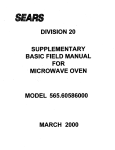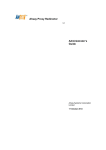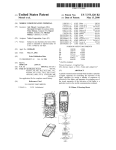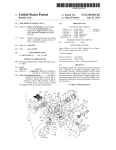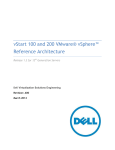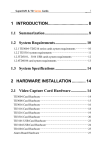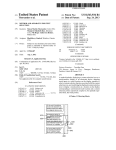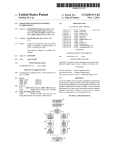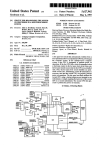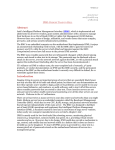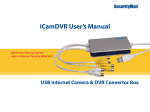Download Interactive firmware recovery
Transcript
US008230210B1
(12) United States Patent
(10) Patent N0.:
Polyudov
US 8,230,210 B1
(45) Date of Patent:
(54)
INTERACTIVE FIRMWARE RECOVERY
(75)
Inventor.
_
.
*Jul. 24, 2012
OTHER PUBLICATIONS
.
American Megatrends, “AMIBIOS8 Flash Update & BIOS Recovery
Fellks Polyudov, Lilburn, GA (US)
Methodsfversion 1'0, Jun‘ 19, 2003‘
.
(73)
Ass1gnee: America Megatrends, Inc, Norcross,
GA (Us)
(*)
Notice:
USOf?'lAt'
'ldM
19,2010'
U.S.A
l.N.
11 538,221; C Ion mm e
ay
m
pp
0
US Of?cial Action mailed Oct. 21, 2010 in US. Appl. No.
11/538,286.
Subject to any disclaimer, the term of this
Giga-byte Technology Co., GA-K8VT890 AMD Socket 754 Proces
patent is eXtended Or adjusted under 35
sor Motherboard User’s Manual, Rev. 1001, Jun. 10, 2005, pp. 1-80.
U.S.C. 154(b) by 63 days,
Giga-byte Technology Co., Q-Flash Quick Flash BIOS UtilityUser’s
.
.
.
.
.
Thl_s pawnt 1S Sublect to a termmal (115'
claimer.
Manual, PP~ l-l7~
US Notice of Allowance/Allowability dated Feb. 9, 2011 in US.
Appl. No. ll/538,286.
Dell OpenManageTM Server Update Utility 1.1iUser’s Guide, Apr.
(21) Appl. No.: 12/720,268
2005.
US. Appl. No. 11/ 538,286, entitled “Interactive Firmware Update”
(22)
Filed;
Man 9, 2010
?led Oct. 3, 2006, Inventor: Feliks Polyudov.
U.S. Of?cial Action datedApr. 2, 2009 in US. Appl. No. 11/538,286.
-
-
U.S. Of?cial Action dated Nov. 24, 2009 in US. Appl. No.
Related US. Application Data
(63)
11638186‘
Continuation of application No. 11/538,204, ?led on
US Of?ci?lACtiOIl datedAPl li2009iI1U~S~AP1)1~1\l<>~ 11533204
Oct, 3, 2006, now Pat, No_ 7,702,896'
US. Notice ofAllowance/Allowability dated Nov. 23, 2009 in US.
Appl. No. ll/538,204.
(51)
Int. Cl.
(52)
G06F 15/1 77
(200601)
US. Cl. ............................. .. 713/2; 714/36; 717/168
Primary Examiner * Albert Wang
('74) Allgrney) Agent, or Firm iHope Baldauff Hartman,
(58)
Field of Classi?cation Search ...... .. 713/2; 714/36;
LLC
7 1 7/ 1 68
See application ?le for complete search history.
(56)
(57)
Firmware is interactively recoverable prior to loading an
operating system on a computer. Rather than proceeding
References Cited
U.S. PATENT DOCUMENTS
6,941,452 B2
9/2005 Huang
7,143,275 B2
11/2006 Cepulis et al.
7,146,609 B2
7,702,896 B1
2001/0049783
2003/0217358
2004/0015941
2004/0076043
2006/0112386
2008/0126777
A1
A1
A1
A1
A1
A1
through a recovery Without user input, user input about a
recovery is solicited after determining that an update is
needed. Prior to recovering the ?rmware, users may be able
12/2006 Thurstaon et a1.
to, for example, specify con?guration options about the
4/2010 Polyudov
12/2001
11/ 2003
1/ 2004
4/2004
5/2006
ABSTRACT
recovery, cancel the update altogether, and specify a ?rmware
image location. Once input is received, the ?rmware recovery
Chen
Thurston et al.
Sekine
Boals et a1.
Moon et al.
proceeds.
20 Claims, 8 Drawing Sheets
5/2008 Chang et a1.
RECOGNIZE
RECOVERY
CONDWION
US. Patent
Jul. 24, 2012
US 8,230,210 B1
Sheet 1 0f 8
100
CPU
102
E
116
U
R
SO
N
0 T
W.%
mm
i
UGA
%mA m D E
600
118
Rm0LTP_HENT1T
MM
SA
S
120
<
‘
2
MYEm0MTmgmHEmw=
86DTNCCNIM1NYEHTOASALEE1“WGERM4mORMDUAmm.
mm
own
%8NS
_D|n
mDR
DST
ANA
N
M
BCGSU
ANEOAE
24n080
8
122
RRT
B
4
=
124
U8
>
FIRMWARE
136
m
FIG. 1
RN
EN
H
U
Q
SUPER I/O
DEVICE
138
US. Patent
Jul. 24, 2012
Sheet 2 of8
OPERATING SYSTEM
2 2
212
EXTENSIBLE FIRMWARE
INTERFACE
E
I
BIOS COMPATIBILITY
SUPPORT MODULE
2 8
HARDWARE
210
FIG. 2
US 8,230,210 B1
US. Patent
Jul. 24, 2012
Sheet 3 of8
US 8,230,210 B1
OPERATING SYSTEM
E
EFI OS LOADER
E
EFI BOOT SERVICES
EFI RUNTIME SERVICES
M
E
SMBIOS
ACP|
PLATFORM SPECIFIC FIRMWARE
E
EFI BOOT LOADER
&
%
PLATFORM
314
HARDWARE
E
EFI SYSTEM
PARTITION
OS
PARTITION
E
E
FIG. 3
US. Patent
Jul. 24, 2012
Sheet 4 of8
US 8,230,210 B1
.OEw
mow
wow
Emu
US. Patent
Jul. 24, 2012
Sheet 7 of8
US 8,230,210 B1
700
701
N
RECOGNIZE
RECOVERY
CONDITION
703
SOLICIT
OPTIONS
DETERMINE
IMAGE
LOCATION
I
UPDATE
IMAGE
709
FIG. 7
706
US. Patent
Jul. 24, 2012
US 8,230,210 B1
Sheet 8 0f 8
800
801
803
GLOBAL
INITIALIZATION
804
V
INITIALIZE
'
AREA
811
/\/
NEXT
805
D|sABLE
BLOCK
A
'
806
UPDATE
INTERRUPTS
'
BLOCK
807
810
809
N
ENABLE
INTERRUPTS &
UPDATE MESSAGE
ENABLE
INTERRUPTS &
UPDATE MESSAGE
/'\/
—
812
NEXT
‘7
ERROR
AREA
G
ENABLE
INTERRUPTS &
UPDATE MESSAGE
FIG. 8
( ELIVD }
US 8,230,210 B1
1
2
INTERACTIVE FIRMWARE RECOVERY
receiving user input prior to loading the operating system, and
updating the ?rmware instructions in accordance with the
input.
CROSS-REFERENCE TO RELATED
APPLICATIONS
Also provided are computer-readable media with com
puter-executable instructions, including launching a ?rm
This application is a continuation of US. patent applica
tion Ser. No. 11/538,204 ?led Oct. 3, 2006, entitled “Interac
tive Firmware Recovery”, now US. Pat. No. 7,702,896 which
is incorporated herein by reference. US. Pat. No. 7,702,896 is
ware setup utility when it’ s determined that a ?rmware recov
ery is needed, displaying a recovery page in the setup utility,
and the receiving input from a user for proceeding with the
?rmware recovery.
Also provided are systems for recovering computer ?rm
related to US. Pat. No. 7,762,736 issued on Jun. 14, 2011,
ware, including two modules. A recovery module determines
the need for a ?rmware recovery, receives input needed to
entitled “Interactive Firmware Update”, which is incorpo
rated herein by reference.
perform the recovery, and performs the recovery itself. A
setup module displays information about the ?rmware recov
ery on a display, displays the input needed, and receives the
BACKGROUND
input from a user.
Many computer systems utiliZe a ?rmware program stored
in non-volatile memory to assist with the start up of the
computer and to enable communication with low level hard
ware. For instance, many personal computer systems utiliZe a
Other systems, methods, and/or computer program prod
ucts according to embodiments will be or become apparent to
one with skill in the art upon review of the following drawings
20
basic input/ output system (BIOS) and/or additional ?rmware
that includes program code containing fundamental routines
that help transfer information between elements within the
computer. In many computer systems, the ?rmware is stored
and Detailed Description. It is intended that all such addi
tional systems, methods, and/ or computer program products
be included within this description, be within the scope of the
present invention, and be protected by the accompanying
claims.
as groups of memory blocks in one or more non-volatile 25
memory devices. From time to time, it may be necessary to
update ?rmware such as, for instance, when a newer version
of the ?rmware is available. It may also be necessary to
recover a previous ?rmware version, such as when the current
?rmware is somehow corrupted.
BRIEF DESCRIPTION OF THE DRAWINGS
FIG. 1 is a computer architecture diagram that illustrates
various components of a computer that provides an illustra
30
mated fashion. This may occur at the behest of a management
agent installed on the computer or on another computer con
nected via a network, or at the behest of the ?rmware itself, for
example, when code determines that the ?rmware has been
35
natively invoke a ?rmware update using a special keyboard
combination, a jumper or switch, or some other form of
40
DETAILED DESCRIPTION
The following detailed description is directed to appara
tuses and methods for interactively recovering and updating
45
?rmware on a computer. In the following detailed description,
references are made to the accompanying drawings that form
a part hereof, and which are shown, by way of illustration,
using speci?c embodiments or examples. Referring now to
the drawings, in which like numerals represent like elements
50
through the several ?gures, aspects of the various implemen
puters thinking the system had froZen or crashed. Powering
down a computer during ?rmware update may cause unin
tended problems, or at least needlessly slow progress. In
addition to a lack of feedback, existing update and recovery
tations and an illustrative operating environment provided
herein will be described.
FIG. 1 and the following discussion are intended to provide
processes do not permit a user to con?gure the process, to
cancel or rollback an update, or to otherwise control the
process.
It is with respect to these considerations and that the
embodiments of the present invention have been made.
FIG. 4 depicts program modules which may be utiliZed as
part of a computer boot process;
FIGS. 5 and 6 depict examples of a display as provided by
interactive ?rmware update; and
FIGS. 7 and 8 are both ?ow diagrams illustrating examples
of processes for providing interactive ?rmware updates.
corrupted and a recovery may be required. A user may alter
manual intervention. However, once invoked, an update pro
ceeds without permitting user input or providing feedback on
progress.
The delay inherent in a ?rmware update can lead to the
computer appearing to be frozen, with no screen updates and
no response from input devices such as an attached keyboard.
This delay prompted many users to power down their com
tive operating environment;
FIGS. 2 and 3 are computer architecture diagrams that
illustrate aspects of an Extensible Firmware Interface (EFI)
environment that may be utiliZed by implementations;
The updating of ?rmware previously occurred in an auto
a brief, general description of a suitable computing environ
55
ment in which the embodiments described herein may be
60
programs, components, data structures, and other types of
structures that perform particular tasks or implement particu
lar abstract data types. Moreover, those skilled in the art will
appreciate that the embodiments described herein may be
implemented. Generally, program modules include routines,
SUMMARY
It should be appreciated that this Summary is provided to
introduce a selection of concepts in a simpli?ed form that are
further described below in the Detailed Description. This
Summary is not intended to identify key features or essential
features of the claimed subject matter, nor is it intended to be
used to limit the scope of the claimed subject matter.
Provided are methods for recovering ?rmware instruc
tions. The method includes determining that a ?rmware
recovery is needed prior to loading an operating system,
practiced with other computer system con?gurations, includ
ing hand-held devices, multiprocessor systems, microproces
sor-based or programmable consumer electronics, minicom
65
puters, mainframe computers, and the like. The embodiments
described herein may also be practiced in distributed com
puting environments where tasks are performed by remote
processing devices that are linked through a communications
US 8,230,210 B1
3
4
network. In a distributed computing environment, program
modules may be located in both local and remote memory
puter-readable media, provide non-volatile storage for the
computer 100. Although the description of computer-read
storage devices.
able media contained herein refers to a mass storage device,
such as a hard disk or CD-ROM drive, it should be appreci
Turning now to FIG. 1, an illustrative computer architec
ture for practicing the embodiments presented herein will be
described. It should be appreciated that although the embodi
ated by those skilled in the art that computer-readable media
ments described herein are discussed in the context of a
puter 100. By way of example, and not limitation, computer
readable media may comprise computer storage media and
communication media. Computer storage media includes
volatile and non-volatile, removable and non-removable
media implemented in any method or technology for storage
can be any available media that can be accessed by the com
conventional desktop or server computer, virtually any type
of computing device may be utiliZed. FIG. 1 shows an illus
trative computer architecture for a computer 1 00 that is opera
tive to interactively recover or update an installed ?rmware.
In order to provide the functionality described herein, the
of information such as computer-readable instructions, data
structures, program modules or other data. Computer storage
media includes, but is not limited to, RAM, ROM, EPROM,
computer 100 includes a baseboard, or “motherboard”, which
is a printed circuit board to which a multitude of components
or devices may be connected by way of a system bus or other
communication path. In one illustrative embodiment, a CPU
102 operates in conjunction with a chipset 104. The CPU 102
is a standard central processor that performs arithmetic and
EEPROM, ?ash memory or other solid state memory tech
nology, CD-ROM, DVD, HD-DVD, BLU-RAY, or other opti
cal storage, magnetic cassettes, magnetic tape, magnetic disk
storage or other magnetic storage devices, or any other
logical operations necessary for the operation of the com
puter. The computer 100 may include a multitude of CPUs
102.
Chipset 104 includes a northbridge 106 and a southbridge
108. Northbridge 106 provides an interface between CPU 102
medium which can be used to store the desired information
20
and which can be accessed by the computer.
25
A low pin count (LPC) interface may also be provided by
the southbridge 108 for connecting a Super I/O device 138.
The Super I/O device 138 is responsible for providing a
number of input/output ports, including a keyboard port, a
mouse port, a serial interface, a parallel port, and other types
and the remainder of computer 100. Northbridge 106 also
provides an interface to a random access memory (RAM)
used as a main memory 114 in computer 100 and, possibly, to
of input/output ports. The LPC interface may also connect a
an on-board graphics adapter 112. Northbridge 106 may also
computer storage media such as a ROM or a ?ash memory
include functionality for providing networking functionality
such as a NVRAM 137 for storing the ?rmware 136 that
through a gigabit Ethernet adapter 110. Gigabit Ethernet
includes program code containing the basic routines that help
adapter 110 is capable of connecting computer 100 to one or
30
more other computers via a network. Connections which may
be made by adapter 110 may include local area network
to start up the computer 100 and to transfer information
between elements within the computer 100. Firmware 136
may include a ?rmware that is compatible with the Extensible
(LAN) or wide area network (WAN) connections. LAN and
Firmware Interface (EFI) speci?cation. It should be appreci
WAN networking environments are commonplace in o?ices,
ated that in addition to ?rmware 136 including an EFI-com
enterprise-wide computer networks, intranets, and the Inter
35
patible ?rmware, other types and combinations of ?rmware
net. Northbridge 106 is connected to southbridge 108.
may be included. For instance, ?rmware 136 may comprise a
Southbridge 108 is responsible for controlling many of the
input/output functions of computer 100. In particular, south
Basic Input and Output System (BIOS) ?rmware or other type
bridge 108 may provide one or more universal serial bus
regarding the operation of the EFI ?rmware 136 are provided
of ?rmware known to those in the art. Additional details
below with respect to FIGS. 2 and 3.
It should be appreciated that the computer 100 may com
(USB) ports 116, a sound adapter 124, an Ethernet controller
134, and one or more general purpose input/output (GPIO)
pins 118. Southbridge 108 may also provide a bus for inter
facing peripheral card devices such as a SCSI host bus adapter
130. In one embodiment, the bus comprises a peripheral
40
component interconnect (PCI) bus. Southbridge 108 may also
45
those skilled in the art. It is also contemplated that the com
puter 100 may not include all of the components shown in
FIG. 1, may include other components that are not explicitly
shown in FIG. 1, or may utiliZe an architecture completely
different than that shown in FIG. 1.
Southbridge 108 is also operative to provide one or more
interfaces for connecting mass storage devices to computer
100. For instance, according to an embodiment, southbridge
108 includes a serial advanced technology attachment
(SATA) adapter for providing one or more serial ATA ports
50
Referring now to FIG. 2, additional details regarding the
operation of the EFI ?rmware 136 of the computer 100 will be
described. In most computing systems, low level instruction
120 and an ATA100 adapter for providing one or more
55
prise other types of computing devices, including hand-held
computers, embedded computer systems, personal digital
assistants, and other types of computing devices known to
provide a system management bus 132 for use in managing
the various components of computer 100. Power manage
ment circuitry 126 and clock generation circuitry 128 may
also be utiliZed during the operation of southbridge 108.
code is used as an intermediary between the hardware com
ponents of the computing system and the operating software
and other high level software executing on the computing
ATA100 ports 122. Serial ATA ports 120 and ATA100 ports
system. In some computer systems, this low-level instruction
122 may be, in turn, connected to one or more mass storage
code is known as BIOS 208. BIOS 208 may provide a set of
devices storing an operating system and application programs
software routines that allow higher-level software to interact
with the hardware 210 of the computing system using stan
and other data. As known to those skilled in the art, an oper
ating system comprises a set of programs that control opera
tions of a computer and allocation of resources. An applica
tion program is software that runs on top of the operating
system software, or other runtime environment, and uses
60
computer resources to perform application speci?c tasks
desired by a user of computer 100.
The mass storage devices connected to the southbridge 108
and the SCSI host bus adapter 130, and their associated com
65
dard calls.
Because of limitations of the BIOS in many computers, a
new speci?cation for creating the ?rmware that is responsible
for booting the computer and for inter'mediating the commu
nication between the operating system and the hardware has
been created. The speci?cation is called the Extensible Firm
ware Interface (EFI) speci?cation, which was originally cre
ated by INTEL CORPORATION and which is also being
US 8,230,210 B1
5
6
extended by the UNIFIED EXTENSIBLE FIRMWARE
INTERFACE FORUM (UEFI).
The EFI speci?cation describes an interface 206 between
operating system 202 and ?rmware 136. In particular, the
EFI boot services 304 provide interfaces for devices and
system functionality that can be used during boot time. EFI
runtime services 306 may also be available to the OS loader
302 during the boot phase. For example, a minimal set of
runtime services may be presented to ensure appropriate
abstraction of base platform hardware resources that may be
speci?cation de?nes the interface that platform ?rmware
must implement and the interface that the operating system
may use in booting and accessing hardware. How the ?rm
needed by the operating system 202 during its normal opera
tion. EFI allows extension of platform ?rmware by loading
EFI driver and EFI application images which, when loaded,
ware implements the interface is left up to the manufacturer of
the ?rmware. The EFI speci?cation provides protocols for
have access to all EFI-de?ned runtime and boot services.
EFI drivers to communicate with each other, and the EFI core
provides functions such as allocation of memory, creating
events, setting the clock, and many others.
As described above, ?rmware 136 may include a ?rmware
compatible with the EFI speci?cation from INTEL CORPO
RATION or from the UEFI FORUM. The speci?cation
de?nes a way for the operating system 202 and ?rmware 136
to communicate only information necessary to support the
operating system boot process. This may be accomplished
through a formal and complete abstract speci?cation of the
software-visible interface presented to the operating system
by the platform and the ?rmware.
According to one implementation of EFI on INTEL COR
PORATION IA-32 platforms, both EFI 206 and a BIOS 208
may be present in ?rmware 136. This allows users and system
integrators to support both ?rmware interfaces. In order to
20
25
loading of an operating system 202. Setup utility 403 may be
30
initiated at the behest of a user (e.g., depressing a special key
or combination of keys), at the behest of a management agent
stored on computer 1 00 or on another computer connected by
a network, and/or at the behest of the instructions stored in
?rmware 136 itself. In the latter situation, a power-on self-test
provide this functionality, an interface 212 may be provided
for use by legacy operating systems and applications. Addi
tional details regarding the architecture and operation of EFI
206 are provided below with respect to FIG. 3. Moreover,
Various program modules provide the boot and runtime
services. These program modules may be loaded by the EFI
boot loader 312 at system boot time. The EFI boot loader 312
is a component in the EFI ?rmware that determines which
program modules should be explicitly loaded and when. Once
the EFI ?rmware is initialiZed, it passes control to the boot
loader 312. The boot loader 312 is then responsible for deter
mining which of the program modules to load and in what
order. It should be appreciated that both operating system 202
and ?rmware 136 may provide a runtime environment for
application programs as described herein.
FIG. 4 depicts program modules which may be utiliZed as
part of the boot process of computer 100. During a boot
process, a setup utility 403 may be initiated prior to the
additional details regarding the operation and architecture of
EFI can be found in either version 1.10 of the EFI speci?ca
(POST) may be performed which may verify the integrity of
the instructions stored in ?rmware 136. This may include
tion available from INTEL CORPORATION and/ or version
evaluating the instructions stored on ?rmware 136 to deter
2.0 of the UEFI speci?cation available from the UEFI
mine whether they have been corrupted or modi?ed inappro
priately. If it is found that ?rmware 136 is lacking integrity,
setup utility 403 may be initiated without external interven
FORUM, both of which are expressly incorporated herein by
35
reference.
A portion of non-volatile storage may be set aside as a boot
tion.
block (not shown). The boot block may constitute, for
example, a block of memory in NVRAM 137 which may be
dif?cult or impossible to update. The boot block may include
a reduced set of computer instructions which, when executed,
check the ?rmware 136 to ensure that the instructions stored
therein are not corrupted or otherwise modi?ed, and then
appropriately update, recover, load, and/or execute some por
tion of ?rmware 136.
Turning now to FIG. 3, additional details regarding an EFI
speci?cation-compliant system which may be utiliZed to pro
vide an operating environment for the various implementa
tions presented herein will be described. As shown in FIG. 3,
the system includes platform hardware 316 and an operating
system (OS) 202. The platform ?rmware 308 may retrieve an
OS image from the EFI system partition 318 using an EFI OS
loader 302. The EFI system partition 318 may be an architec
40
Setup utility 403, in conjunction with screen manager 404,
may display information and options on a display 405. The
combination of input and output may allow a user to con?gure
setup options, or otherwise work interactively with setup
45
An interactive ?rmware update module 401 may include
screen manager 404, and other code stored on computer 100.
Interactive ?rmware update module 401 may allow a user to
50
55
computer 100, may access a new ?rmware image and either
execute or extract portions of the new ?rmware image. The
?rmware image may include instructions which call or inter
act with setup utility 403 and/ or screen manager 404. In
401 may be stored in or otherwise accessed from a new
60
other supported speci?cations to survey, comprehend, and
initialiZe the various platform components and the operating
system software that manages them. Thus, interfaces 314
from other speci?cations may also be present on the system.
For example, the Advanced Con?guration and Power Man
interact with an executing ?rmware update, providing infor
mation to the user via display 405, and receiving selections
and commands via input devices such as keyboard 406. Inter
active ?rmware update module 401, or other code stored on
additional embodiments, interactive ?rmware update module
complete operating system 202. In doing so, the EFI OS
loader 302 may use EFI boot services 304 and interface to
utility 403.
instructions which work in conjunction with setup utility 403,
turally shareable system partition. As such, the EFI system
partition 318 de?nes a partition and ?le system that are
designed to allow safe sharing of mass storage between mul
tiple vendors. An OS partition 320 may also be utiliZed.
Once started, the EFI OS loader 302 continues to boot the
Setup utility 403 may include and/or may otherwise work
with screen manager 404. Setup utility 403 may receive and
process input from a user via, for example, a keyboard 406.
?rmware image.
FIG. 5 depicts an example of a display 501 as provided by
interactive ?rmware update module 401 in conjunction with
setup utility 403 and screen manager 404. Display 501 may be
shown during a computer’s boot operation. Display 501
65
shows that computer 100 has detected a recovery condition. It
agement Interface (ACPI) and the System Management BIOS
should be noted that although the example here applies spe
(SMBIOS) speci?cations may be supported.
ci?cally to an EFI recovery, other instructions stored in the
US 8,230,210 B1
7
8
?rmware may be the subject of a recovery or an update.
Display 501 includes a set of options 502 that a user can
attached claims. Moreover, it Will be apparent to those skilled
in the art that the operations described may be combined,
manipulate using an input device, as Well as a proceed instruc
divided, reordered, skipped, and otherWise modi?ed, also
tion 503, Which enables the user to initiate a recovery once the
Without deviating from the spirit and scope of the attached
user is satis?ed With the options. In addition, setup utility 403
may provide a description 505 of a currently selected option,
claims.
as Well as input instructions 504 Which instruct the user about
manipulating the options. By providing display 501, a user
determining that a recovery is to be initiated. Determining the
need for a recovery may be accomplished by determining, for
may control the speci?cs of the recovery, and also may con
example, that the current ?rmWare image has been corrupted;
Routine 700 begins With operation 701, Which involves
trol its progress. In some embodiments, a user may be unable
or that a remote computer connected to computer 100 via a
to con?gure options or control progress When, for example,
netWork has requested a recovery. At decision 702, the ?rm
Ware update routine determines Whether the recovery is to be
the recovery Was triggered by an administrator Who Wishes to
limit interactivity by an end user.
conducted in an interactive fashion. This determination may
be made in a number of Ways. Interactivity may be an option
When a user is shoWn display 501, the user may direct or
move a cursor and select an option, modify it, and then pro
set by a user of computer 100, or by a local or remote man
ceed to another option. Options may include, for example,
resetting BIOS, EFI, or other con?guration options; updating
agement agent. Actions preceding a recovery may also deter
mine interactivity. For example, if a user poWered up com
puter 100 manually, and it is determined that a recovery is
the boot block in addition to the remainder of the ?rmWare;
ignoring the recovery condition; and booting the operating
system using a neW ?rmWare image Without performing an
needed, the process may automatically decide that the update
20
is interactive. Alternatively, if a remote computer initiated the
25
recovery, then the recovery may proceed automatically With
out interactivity. Additionally, interactivity may be deter
mined depending on the level of ?rmWare corruption
detected. If, for example, corruption is minimal, a user may be
presented With more options to con?gure and/or diagnose the
update. In addition to setting options for the impending recov
ery, a user may be able to perform other functions prior to
performing the recovery, including, for example, testing the
old ?rmWare image, and testing the neW ?rmWare image.
Additional options and functions may enable the user to
select and/ or doWnload a neW ?rmWare image from a remote
issue. HoWever, if the corruption is severe, a recovery may
computer via a netWork connection prior to performing an
proceed Without interactivity.
update.
If a recovery is determined to be non-interactive, then the
recovery procedure continues at operation 705. If otherWise a
recovery is determined to be interactive, then at operation
FIG. 6 depicts a display 601 similar to display 501 of FIG.
5, including input instructions 504. Display 601 informs a
30
user as to the ongoing progress of an update or recovery. As
703, the computer solicits the entry of options to con?gure the
such, a user Will not mistakenly believe that computer 1 00 has
froZen because a progress message 603 is refreshed during
?rmware recovery procedure. Options may be solicited by
the update. Both displays 501 and 601 may be generated With
the assistance of setup utility 403 and/ or screen manager 404,
or With another softWare module not requiring an operating
35
shoWing them on display 405, and receiving input from a user
via keyboard 406. Options on display 405 may be shoWn by
providing option information to setup utility 403. For
example, When a recovery condition is determined, informa
system to be loaded. Display 601 may be shoWn immediately
tion about recovery interactivity (e.g., con?guration options
folloWing a selection made by the user on display 501. Alter
and progress feedback) may be placed in a table or similar
data structure. When setup utility 403 executes, it may
retrieve this information and display recovery page 501.
natively, display 601 may be shoWn independently, such as in
the case Where no options may be available for the update or
recovery, When the update or recovery is determined not to be
40
Other methods for providing information about options
and receiving input may be available. Once input is received
regarding options, information about the input may be stored
for use during the recovery procedure. Soliciting input may
interactive, or in any situation Where ?rmWare is being
updated.
Display 601 may include a Warning message 602 and an
updated progress message 603. Warning message 602 may be
45
include requesting that a user press a key before proceeding.
At operation 704, it is determined Whether the recovery pro
used to remind the user not to poWer doWn or otherWise
disrupt computer 100 during the update or recovery. Progress
cedure should proceed. This may be determined based on user
message 603 is repeatedly updated so as to shoW the user that
input, or based on one or more selected options. The ?rmWare
recovery procedure may exit at this point Without performing
the ?rmWare update or recovery is progressing. Details Will
be provided beloW With respect to FIG. 8 as to hoW progress
50
message 603 may be generated and displayed.
At operation 705, the location of a neW ?rmWare image is
FIG. 7 is a How diagram illustrating an example of a pro
cess for providing an interactive ?rmWare recovery. The logi
located. The neW ?rmWare image refers to a set of computer
cal operations of the various implementations presented,
including those of FIGS. 7 and 8, may be (1) a sequence of
computer implemented acts or program modules running on
55
computer 100 and/or (2) interconnected machine logic cir
cuits or circuit modules Within computer 100. The implemen
tation is a matter of choice dependent on the performance
requirements of the computer on Which the embodiments are
Ware, in special purpose digital logic, and/or any combination
thereof Without deviating from the spirit and scope of the
instructions stored someWhere outside the ?rmWare Which
may be used to update the ?rmWare. Either partial or full
?rmWare updates may be stored in the neW ?rmWare image.
The image may be stored in the memory of computer 100, on
a non-volatile storage medium (e.g., a hard drive or USB
drive) associated With computer 1 00, or on a remote computer
connected via a netWork connection. At operation 706, the
60
implemented. Accordingly, the logical operations making up
the implementations are referred to variously as operations,
structural devices, acts, or modules. It Will be recognized by
one skilled in the art that these operations, structural devices,
acts, and modules may be implemented in softWare, in ?rm
the update. OtherWise, the recovery proceeds.
?rmWare update operation occurs. The ?rmWare update
operation may involve copying the ?rmWare image from one
location to another and/or overWriting an outdated or cor
rupted set of instructions. In some embodiments, the ?rm
65
Ware update operation may involve utiliZing the interactive
process depicted in FIG. 8.
Upon completion of an update operation, at decision 707,
again depending on Whether the recovery procedure is
US 8,230,210 B1
9
10
intended to be interactive or not, additional input may be
requested. This may be a request to con?rm or commit the
update and/or to press a key to continue. If interactive, once
input is received at decision 708, then at operation 709, com
puter 100 may be reset, or the ?rmware will otherwise be
restarted with the new ?rmware image installed.
FIG. 8 is a ?ow diagram illustrating an example of a pro
cess for providing interactive ?rmware updates. The routine
800 depicted in this example may or may not work as part of
the process 700 set forth above. In other words, routine 800
ongoing update operation on hold and then update the
progress message. The update module may then return con
trol to setup utility 403, which can then utiliZe screen manager
404 to update the progress message shown on display 405.
The setup utility may then make a call to the interactive
?rmware update module to resume the update.
Returning to decision 808, if this is the last block in the
current area, and at decision 812, this is not the last area, then
at operation 813, the next area is determined, and the new area
is initialiZed for update at operation 804. If this is the last
block of the last area at decision 812, then at operation 814,
interrupts may be enabled, the progress message may be
may be used in the handling of update operation 706. At
decision 801, interactivity is determined in any of a number of
ways, but does not necessarily need to be determined in the
updated, and the keyboard is unlocked. At decision 815, if the
update is intended to be interactive, then at decision 816,
some input (e.g., “Press a key to restart computer”) is
awaited. At operation 817, the computer is reset, causing it to
use the newly updated ?rmware.
same fashion as the interactivity determined at decision 702.
At decision 802, if interactive, an input may be waited on
before proceeding. The input may merely be a depressed key
signaling that the update should begin. At operation 803, a
global initialiZation occurs, wherein variables and procedures
Although the subject matter presented herein has been
are initialiZed prior to beginning the actual update. Global
initialiZation 803 may determine the number of blocks and/or
areas to be updated, and may also determine the location of
20
described in conjunction with one or more particular embodi
ments and implementations, it is to be understood that the
invention de?ned in the appended claims is not necessarily
limited to the speci?c structure, con?guration, or functional
the ?rmware image. Other calculations may be determining
an address delta between a ROM address and a RAM address.
ity described herein. Rather, the speci?c structure, con?gu
In addition, the keyboard (or other input device) may be
ration, and functionality are disclosed as example forms of
locked, and warning message 602 may be initialiZed. Other
25
initialiZed variables may include a progress message. The
progress message may be stored as a string of characters.
illustration only and should not be construed as limiting.
Various modi?cations and changes may be made to the sub
At operation 804, initialiZation speci?c to an area of the
?rmware image occurs. An area may represent a subdivision
of the ?rmware image, although the image may be stored
30
within a single area. An area may include one or more blocks
of data. A ?rst block within the area may also be determined
during operation 804, and the previously determined address
1. A computer-implemented method for recovering a plu
35
computer;
re-enabled and the keyboard selectively unlocked.
in response to determining that the plurality of ?rmware
40
then at operation 809, interrupts are enabled and the progress
message may be updated to re?ect the error. In addition,
during operation 809, an error recovery routine may be acti
vated, one which may, for example, replace previously stored
?rmware and override the update. In addition, the keyboard is
rality of ?rmware instructions, the method comprising:
determining whether the plurality of ?rmware instructions
need recovery prior to loading an operating system on a
block may be copied into ?rmware, or elsewhere in memory.
Also, during block update 806, interrupts may be selectively
If, at decision 807, there was an error during a block update,
ject matter described herein without following the example
embodiments and applications illustrated and described, and
without departing from the true spirit and scope of the present
invention, which is set forth in the following claims.
What is claimed is:
delta used to determine a location for the block. At operation
805, interrupts may be disabled, preventing their disturbing
the block update at operation 806. During operation 806, the
implementing the claims.
The subject matter described above is provided by way of
instructions need recovery, determining whether recov
ery of the ?rmware instructions is to be conducted in an
interactive fashion;
45
in response to determining that recovery of the ?rmware
instructions is to be conducted in an interactive fashion,
soliciting a user to supply an input regarding the recov
the last block within the area at decision 808, then at operation
ery prior to loading the operating system, receiving the
input from the user, and updating the plurality of ?rm
810, interrupts may be enabled, and the progress message
may be updated to re?ect further progress towards updating
ware instructions in accordance with the input; and
in response to determining that recovery of the ?rmware
unlocked. If there are no errors at decision 807, and this is not
the ?rmware. The updated message may re?ect an additional
percentage of the area or ?rmware being completed. Proceed
ing to the next block at operation 811, interrupts are once
again disabled at operation 805. The period between re-en
50
ion, updating the plurality of ?rmware instructions with
out receiving user input.
2. The method of claim 1, wherein soliciting a user to
abling and disabling interrupts may allow a separate process
or set of instructions to interrupt the ongoing ?rmware
update. Such an interrupt may include a setup utility 403 or
55
parameter for specifying whether a plurality of options
60
an interrupt.
In some embodiments, setup utility 403 may make periodic
calls to the interactive ?rmware update module during the
?rmware update. These calls from the setup utility may be
immediately handled, may be deferred, or may be ignored by
the interactive ?rmware update module. When handling these
calls, the interactive ?rmware update module may put the
supply an input regarding the update prior to loading the
operating system comprises displaying an option for modi?
cation.
3. The method of claim 2, wherein the option comprises a
screen manager 404 interrupting or calling back to retrieve or
access the most recent progress message. Likewise, the
updated progress message may be pushed by the ?rmware
update routine to update the screen without necessarily using
instructions is not to be conducted in an interactive fash
should be reset to default values during the updating of the
plurality of ?rmware instructions.
4. The method of claim 2, wherein the option comprises a
parameter for specifying whether contents of a boot block
should be updated during the updating of the plurality of
?rmware instructions.
65
5. The method of claim 1, further comprising:
launching a ?rmware setup utility prior to loading the
operating system; and
US 8,230,210 B1
11
12
display a repeatedly updated visual indicator of progress
while proceeding with the recovery of the computer
displaying a recovery page using the setup utility prior to
solicit the user to provide an input.
6. The method of claim 5, further comprising:
displaying a repeatedly updated visual indicator of
progress while updating the plurality of ?rmware
?rmware.
15. The computer-readable medium of claim 10, wherein
the instructions are all executed prior to the loading of an
instructions.
operating system.
7. The method of claim 1, wherein determining whether
16. The computer-readable medium of claim 10, wherein
recovery of the ?rmware instructions is to be conducted in an
determine whether recovery of the ?rmware instructions is to
be conducted in an interactive fashion comprises:
determining whether a user powered up the computer; and
conducting the recovery of the ?rmware instructions in an
interactive fashion if the user powered up the computer.
interactive fashion comprises:
determining whether a user powered up the computer; and
conducting the recovery of the ?rmware instructions in an
interactive fashion if the user powered up the computer.
8. The method of claim 1, wherein determining whether
17. The computer-readable medium of claim 10, wherein
recovery of the ?rmware instructions is to be conducted in an
determine whether recovery of the ?rmware instructions is to
be conducted in an interactive fashion comprises:
determining whether a remote computer initiated the
recovery; and
interactive fashion comprises:
determining whether a remote computer initiated the
recovery; and
conducting the recovery of the ?rmware instructions with
out receiving user input if the remote computer initiated
the recovery.
9. The method of claim 1, wherein determining whether
conducting the recovery of the ?rmware instructions with
out receiving user input if the remote computer initiated
20
interactive fashion comprises:
determine whether recovery of the ?rmware instructions is to
be conducted in an interactive fashion comprises:
determining a level of corruption of the ?rmware instruc
determining a level of corruption of the ?rmware instruc
tions;
conducting the recovery of the ?rmware instructions with
out interactivity if the level of corruption of the ?rmware
25
tions;
conducting the recovery of the ?rmware instructions with
out interactivity if the level of corruption of the ?rmware
instructions is severe; and
conducting the recovery of the ?rmware instructions with
interactivity if the level of corruption of the ?rmware
instructions is minimal.
instructions is severe; and
conducting the recovery of the ?rmware instructions with
interactivity if the level of corruption of the ?rmware
instructions is minimal.
10. A non-transitory computer-readable medium having
computer-executable instructions stored thereon which,
19. A computer system con?gured for interactive recovery
of a ?rmware, the computer system comprising:
when executed by a computer, cause the computer to:
determine whether a recovery of a computer ?rmware of
one or more central processing units; and
the computer is needed; and
a non-volatile memory device having instructions stored
in response to determining that a recovery of the computer
?rmware is needed, to determine whether recovery of
the ?rmware is to be conducted in an interactive fashion,
thereupon which, when executed on the one or more
central processing units, cause the computer system
to determine whether the ?rmware needs recovery prior
to loading an operating system on the computer sys
to display a recovery page for soliciting input regarding
the recovery from a user in response to determining that
recovery of the ?rmware is to be conducted in an inter
the recovery.
18. The computer-readable medium of claim 10, wherein
recovery of the ?rmware instructions is to be conducted in an
40
tem,
active fashion, to receive input from the user by way of
to determine whether recovery of the ?rmware is to be
conducted in an interactive fashion in response to
the recovery page, to recover the computer ?rmware in
accordance with the input, and to recover the computer
determining that the ?rmware needs recovery,
in response to determining that recovery of the ?rmware
?rmware without soliciting input from the user in
response to determining that the recovery of the ?rm
45
to loading the operating system, to receive the input
ware is not to be conducted in an interactive fashion.
11. The computer-readable medium of claim 10, wherein
displaying the recovery page comprises displaying a con?gu
ration option for con?guring the recovery.
12. The computer-readable medium of claim 11, wherein
from the user, to update the ?rmware in accordance
with the input, and
to update the ?rmware without receiving user input in
response to determining that recovery of the ?rmware
the con?guration option comprises a parameter for specifying
is not to be conducted in an interactive fashion.
whether con?guration data stored in non-volatile memory
20. The computer system of claim 19, wherein the non
volatile memory device has further computer-executable
should be reset.
13. The computer-readable medium of claim 11, wherein
is to be conducted in an interactive fashion, to solicit
a user to supply an input regarding the recovery prior
55
instructions stored thereupon which, when executed by the
the con?guration option comprises a parameter for specifying
one or more central processing units, causes the computer
whether a boot block should be updated.
system to repeatedly update a display of a progress message
while performing recovery of the ?rmware.
14. The computer-readable medium of claim 10, having
further computer-executable instructions stored thereupon
which, when executed by the computer, cause the computer
to:
60

















